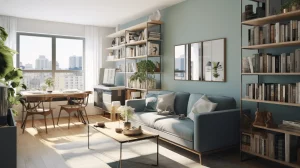Literature can be an unexpected yet powerful ally in the quest to optimize small living spaces. Authors like Virginia Woolf and Ernest Hemingway provide design cues through vivid descriptions that can turn cramped quarters into cozy retreats. By studying how these masters create atmosphere and mood through spatial details, we can discover innovative strategies for making even the tiniest spaces feel expansive and comfortable. The transformation of literary insights into practical design principles is the key to unlocking the potential of small living spaces. Let’s delve into how this can be achieved.
Key Takeaways
- Harmonize functionality and aesthetics to create a sense of comfort and community in small living spaces.
- Employ layered lighting, multifunctional furniture, and textured accents to create depth and visual appeal.
- Declutter and remove unnecessary items to cultivate a clearer mind and a sense of openness.
- Utilize creative storage solutions like vertical shelves, hidden compartments, and storage ottomans to maximize space.
- Incorporate cozy textures, soft lighting, and nurturing hues to create a warm and inviting atmosphere in compact quarters.
Understanding the Challenges of Small Spaces
Managing the constraints of compact quarters can be a challenging endeavor, as every inch counts in small living spaces, where functionality and aesthetics must harmoniously coexist. How to optimize small living spaces requires thoughtful consideration of spatial relationships, efficient storage solutions, and intentional design choices that promote a sense of comfort and community.
Literary Insights for Space Optimization
By examining the spatial relationships and design principles employed in literary descriptions of snug living spaces, we can glean valuable insights on how to optimize petite living areas. These insights can inform our design choices, creating spaces that feel expansive and welcoming. Consider the following principles:
- Layered Lighting: Use a combination of illumination sources to create depth and visual interest.
- Multifunctional Furniture: Choose pieces that serve multiple purposes to maximize functionality.
- Textured Accents: Incorporate varied textures to add depth and visual appeal to small spaces.
Decluttering for a Clearer Mind
As we investigate the realm of small space optimization, it becomes increasingly evident that clutter can be a major obstacle to creating a sense of calm and clarity, making decluttering an essential step in cultivating a clearer mind. By removing unnecessary items, we can create a sense of openness, allowing our minds to breathe and think more clearly.
Creative Storage Solutions Unveiled
Within the confines of compact living spaces, the art of inventive storage solutions emerges as a vital component in the pursuit of visual harmony, as thoughtfully designed storage systems can seamlessly weave together form and function. To maximize space, consider:
- Vertical shelves: Optimize ceiling heights with floor-to-ceiling storage.
- Multifunctional furniture: Invest in pieces that serve dual purposes, like storage ottomans.
- Hidden compartments: Utilize secret storage spaces, such as under-bed containers or hollowed-out books.
Cozying Up in Compact Quarters
Three fundamental elements – texture, light, and color – converge to create a cozy atmosphere in compact quarters, where every detail counts in the pursuit of warmth and comfort. To optimize small living spaces, incorporate plush textiles, soft lighting, and nurturing hues to cultivate a sense of belonging, making even the smallest of spaces feel like home.
Frequently Asked Questions
Can I Use Rugs to Define Different Areas in a Small Living Space?
‘Certainly, rugs can be a smart way to define different areas in a small living space, creating cozy zones and visual boundaries that improve functionality and aesthetic appeal.’
How Do I Choose the Right Color Palette for a Compact Room?
To choose the right color palette for a small room, consider the natural light, furniture, and personal style; select a unifying shade and 2-3 matching colors to create a harmonious, visually expansive atmosphere.
Are There Any Space-Saving Hacks for a Small Kitchen?
To maximize kitchen functionality, consider installing a wall-mounted pot rack, using a compact refrigerator, and opting for multi-functional appliances, such as a toaster oven with a built-in microwave.
Can I Use Mirrors to Make a Small Room Appear Larger?
Strategically placing mirrors in a small room can create the illusion of a larger space by reflecting light and visually expanding the area, making it a shrewd and effective optimization technique.
How Do I Prioritize Furniture Purchases for a Small Living Space?
When prioritizing furniture purchases for a small living area, consider the 3Ws: Importance, Logic, and Sophisticated function, ensuring each piece serves multiple purposes, is proportionate to the space, and aligns with your personal style.
Conclusion
Inhabiting petite living spaces necessitates deliberate design. By integrating layered illumination, multifunctional furniture, and textured accents, compact quarters can be transformed into cozy sanctuaries. Literary insights offer valuable guidance in crafting spaces that feel spacious and welcoming. Through decluttering, innovative storage solutions, and careful attention to detail, small spaces can be optimized for comfort and community. Ultimately, a thoughtful and aesthetically driven approach can transcend spatial limitations, yielding a profound sense of comfort and well-being.
Also read: How Books Shape Your Real Estate Journey


